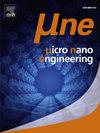用于光刻掩模重建的ai初始化水平集反演
IF 3.1
Q2 ENGINEERING, ELECTRICAL & ELECTRONIC
引用次数: 0
摘要
随着半导体制造中的特征尺寸不断缩小,精确的掩模检测和晶圆级预测变得越来越具有挑战性。本文提出了一种光刻驱动的掩模重建框架,该框架可以从掩模审查员捕获的航空图像中推断出物理上有意义的掩模模式。该方法基于基于堆叠瞳孔移位矩阵的图像形成模型,并确保物理可解释性和与真实光刻过程的对齐。该框架将基于水平集的逆建模方法与Barzilai-Borwein方法和黄金分割搜索等自适应时间步优化方法相结合,保证了收敛效率和稳定性。为了解决水平集方法对初始化的敏感性,引入了一种基于光刻感知数据训练的深度学习模型来生成准确的初始水平集函数。此外,采用上采样技术来克服像素分辨率的限制,并在不增加运行时间的情况下改进掩模边缘的平滑度。实验结果表明,重构后的掩模所生成的航拍图像与掩模审查员的航拍图像非常接近。与旁瓣搜索相比,我们的人工智能初始化方法大大提高了重建精度和收敛性,特别是在涉及亚分辨率辅助特征的情况下。此外,晶圆级评估显示模拟和实际CD变化之间有很强的一致性,匹配斜率始终大于0.8。提出的框架有效地弥合了航空图像分析和晶圆行为预测之间的差距,并为高级掩模审查和验证工作流程提供了强大的可扩展解决方案。本文章由计算机程序翻译,如有差异,请以英文原文为准。

AI-initialized level-set inversion for lithographic mask reconstruction
As feature sizes in semiconductor manufacturing continue to shrink, accurate mask inspection and wafer-level prediction have become increasingly challenging. This paper presents a lithography-driven mask reconstruction framework that infers physically meaningful mask patterns from aerial images captured by mask reviewers. The proposed approach is grounded in an image formation model based on stacked pupil shift matrices and ensures physical interpretability and alignment with real lithography processes. The framework integrates a level-set-based inverse modeling approach with adaptive time-step optimization methods, including Barzilai–Borwein method and Golden Section Search, to ensure convergence efficiency and stability. To address the sensitivity of level-set methods to initialization, a deep learning-based model trained on lithography-aware data is introduced to generate accurate initial level-set functions. Additionally, an upsampling technique is employed to overcome pixel resolution limitations and to refine mask edge smoothness without increasing runtime. Experimental results demonstrate that the reconstructed masks generate aerial images that closely match those from mask reviewers. Compared with the sidelobe search, our AI-initialized method substantially improves reconstruction accuracy and convergence, especially in cases involving subresolution assist features. Furthermore, wafer-level evaluations exhibit strong alignment between simulated and actual CD variations, and matching slopes are consistently above 0.8. The proposed framework effectively bridges the gap between aerial image analysis and wafer behavior prediction, and offers a robust, scalable solution for advanced mask review and verification workflows.
求助全文
通过发布文献求助,成功后即可免费获取论文全文。
去求助
来源期刊

Micro and Nano Engineering
Engineering-Electrical and Electronic Engineering
CiteScore
3.30
自引率
0.00%
发文量
67
审稿时长
80 days
 求助内容:
求助内容: 应助结果提醒方式:
应助结果提醒方式:


